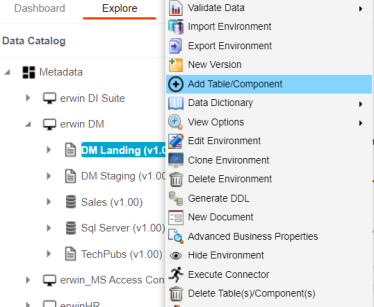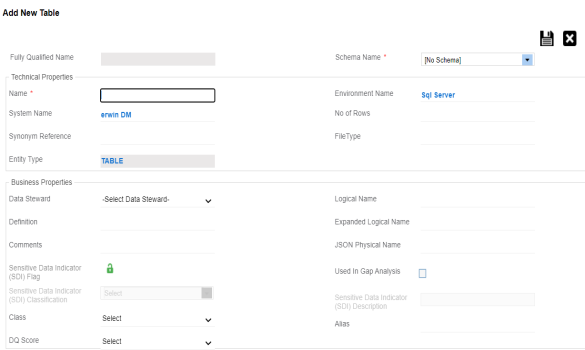You can add tables in an environment manually and define their technical and business properties. You can also use User-Defined Fields to define additional properties of a table. UI labels of the User-Defined fields can be configured in Language Settings.
To add tables, follow these steps:
- Go to Application Menu > Data Catalog > Metadata Manager > Explore.
- In the Data Catalog pane, right-click an environment.
- Click Add Table/Component.
- Enter or select appropriate values in the fields. Refer to the following table for field description.
- Click
 .
.

The Add New Table page appears.

|
Field Name |
Sub-Field |
Description |
|---|---|---|
|
Schema Name |
Specifies the schema name of the table. For example, dbo. |
|
|
Technical Properties |
Name |
Specifies the physical name of the table. For example, Account or Currency. |
|
System Name |
Specifies the physical name of the system under which the table exists. For example, Enterprise Data Warehouse. You cannot edit this field. |
|
|
Synonym Reference |
Specifies the synonym reference of the table. For example, Sales_Rep_Information. This field is autopopulated during the metadadata scan. You cannot enter it manually. |
|
|
Entity Type |
Specifies the entity type of the new component. It is autopopulated with Table. |
|
|
Environment Name |
Specifies the physical name of the environment under which the table exists. For example, EDW-Test. You cannot edit this field. |
|
|
No of Rows |
Specifies the total number of rows in the table. For example, 100. |
|
|
File Type |
Specifies the file type of the table if the table is in a file-based environment. |
|
|
Business Properties
|
Data Steward |
Specifies the name of the data steward responsible for the table. For example, Jane Doe. Users assigned with the Legacy Data Steward role appear as drop down options. You can assign this role to a user in the Resource Manager. To assign data steward, select a data steward from the drop down options. |
|
Definition |
Specifies the definition of the table. For example: The table contains five columns with emp ID column as the primary key. |
|
|
Comments |
Specifies comments about the table. For example: The table contains details of the employees. |
|
|
Class |
Specifies the table class property. For more information on configuring table class, refer to Configuring Table and Column Class topic. |
|
|
DQ Score |
Specifies the overall data quality score of the table. For example, High (7-8). For more information on configuring DQ scores, refer to the Configuring Data Profiling and DQ Scores topic.
This option is not available when the Enable DQ Sync option is switched on for an environment. |
|
|
Logical Table Name |
Specifies the logical name of the table. For example, if the physical name of a table is DIM_Customer, then the logical name of the table is Customer Dimension. |
|
|
Expanded Logical Name |
Specifies the expanded logical name of the table. For example, if the physical name of a table is RM_Resource, then the expanded logical name of the table is RM Sales Representative. You can configure expanded logical name of tables in bulk at system and environment level. |
|
|
JSON Physical Name |
Specifies the JSON physical name of the table if the table is in a JSON environment. For example, account. |
|
|
Used in Gap Analysis |
Specifies whether the table is being used as part of a gap analysis to check table usage in mappings. Select the check box if the table is used in gap analysis. For more information on performing table gap analysis, refer to the Performing Table Gap Analysis topic. |
|
|
Sensitive Data Indicator (SDI) Flag |
Specifies whether the table is sensitive. Switch Sensitive Data Indicator (SDI) Flag to |
|
|
Sensitive Data Indicator (SDI) Classification |
Specifies the SDI classification of the table. For example, PHI. This list is enabled when Sensitive Data Indicator (SDI) Flag is switched to |
|
|
Sensitive Data Indicator (SDI) Description |
Specifies the description of the SDI classification. For example: Protected Health Information. It is enabled when Sensitive Data Indicator (SDI) Flag is switched to |
|
|
Alias |
Specifies the alias name of the table. For example, Sales_Representative_Table. |
The table is added to the environment.
|
Copyright © 2023 Quest Software Inc. |